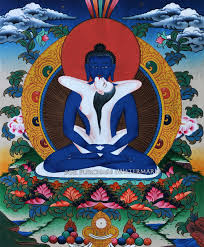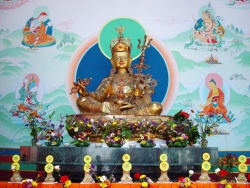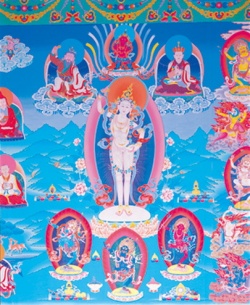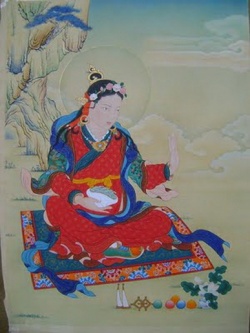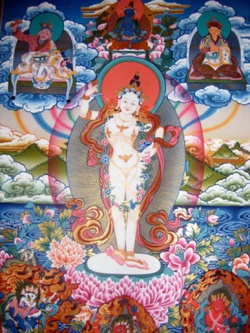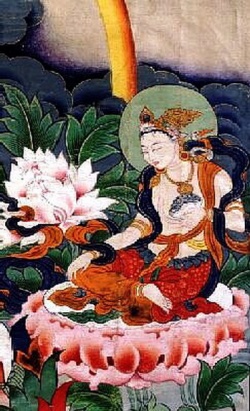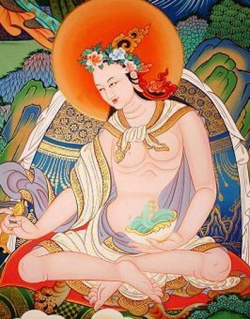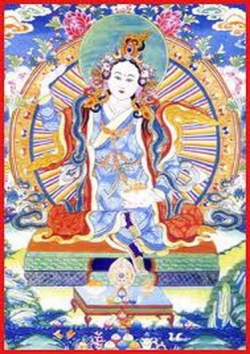Empowerment of Khando Chenmo Yeshe Tsogyel
1.
Empowerment of Khando Chenmo Yeshe Tsogyel
The Female Tantric Buddha
The Practice of the Yeshe Tsogyel Awareness-spell encourages the Strong Laughter of the Dakinis as an aspect of one's existence. This means that one's circumstances become vivid with opportunities for Practices and electric with the immanent
possibilities of Liberation. With this practice, there is the innate encouragement to be vital and alive in each moment, to experience a nakedness of perception and the dynamic continuity of 'the inescapability [sic] of *what is*'. The Completion Phase Practice of Khandro Chenmo Yeshe Tsogyel is to realize Transference of consciousness at the time of Death to the Realised Sphere of her own mind, known as 'o-kar Kang-ri - the Mountain of White Light.'
2.
Waning Moon and Yeshe Tsogyel Tsog-khorlo Envisionment >From within the Lucid Shining Emptiness of my own Being, I instantly arise in the Iridescent Form of the Great Enlightened Dakini; Khandro Chenmo Yeshe Tsogyel. My Gaze is at once Soft and Penetrating; Compassionate yet Playfully Wrathful, in token of my ability [to] infuse all circumstances with vivid
opportunities for Realisation. My Wide Open Eyes Sparkle with the Electricity of Existence and Non-existence and communicate the immanence of Liberation for all Yogis and Yoginis. My mouth is open and my
tongue is flickering. My Strong Laughter overpowers all dualistic conceptions. My hair is wound up in a Yogini's bun on top of my head and ornamented with a golden takdrol topped with a flaming skull. I am naked in token of utter lack of pretension
and complete fearlessness. I am open to the entire universe and the inescapability of what is.
I wear the six human bone cemetery ornaments to show that I have accomplished the six Tantric Vehicles; and, as the sign that I have passed beyond all relative constraints. I wear the Conch Yogini earrings, and Sit on a Tiger skin in display of my mastery of all Siddhis. In my left hand I hold the skull bowl; symbol of the Transformed emotions, and of
Wisdom. The white bone of the skull is the Male Quality of Spacious Passion. The red frothing oceans of menstrual blood within the skull bowl is the Female Quality of Passionate Space. I cradle the
Khatvangha trident in the crook of my left arm. The three points of the khatvanga pierce the fabric of attraction, aversion and indifference. The secret Nature of the Khatvangha is Padhmasambhava who is my Secret Inner Method
nature. In my right hand, I hold the golden Five-Pronged Wrathful Vajra, with which I overpower all apparent phenomena in Bliss-Emptiness. I sit in the Dzogchen Yogini's posture: in Display of the natural condition, in which everything relaxes into its own condition of Primal Purity. My right foot is extended in token of my ability to enter swiftly into Activity for the benefit of Everyone and Everything Everywhere.
B. Yeshe Tsogyel Awareness-spell
OM A'A HUNG BENDZRA GURU JNANA SAGARA
BAM HA RI NI SA SIDDHI HUNG
C. Empowerment Handouts
1. Ngakpa Chogyam Rinpoche - biographic details [Bolds and italics not reproduced in either of these.] Ngakpa Chogyam Rinpoche is an English-born Lama, recognized as the second Incarnation of the Tantric Yogi 'a-Shul Pema Ledgen, by His Holiness Kyabje Khordong Terchen Tulku Chhimed Rigdzin Rinpoche (Holder of the Chang-Ter and Khordong-Ter Lineages of the Nyingma School). The Nyingma are the oldest Tradition of Tantra in Tibet, and the one most directly associated with Padmasambhava (the
Second Buddha who brought Tantra to Tibet). The Nyingma are the Holders of the Dzogchen Teaching - the most Direct and Essential Path of the Three Inner Tantras. The Inner Tantras of the Nyingma is unique in the richness and simplicity of their View and Method, and Ngakpa Chogyam Rinpoche is becoming increasingly well known for his authentic yet
radical presentation of these Ancient Spiritual Treasure Teachings. Kyabje Chhimed Rigdzin Rinpoche (Ngakpa Chogyam Rinpoche's Root Teacher - Spiritual Father) is one of the Great Tertons of this century. The Tertons are Revealers of the Hidden Spiritual Treasures of Padmasambhava, mystically sealed (through his Enlightened Mind-Mandate) to be Discover [sic] at future times.
These Astonishing Teachings were Hidden for future Discovery with the Intention that the Nyingma Tradition would never grow stale, but would continually address the current situation of people in the world. Ter are encoded in the Secret Dakini Script of Khandro Yeshe Tsogyel (the Enlightened Tibetan Woman - Yogini and mystic consort of Padmasambhava) and
they come to light whenever the Tradition is in danger of stagnating through the human cultural tendency to atrophication. Ter re-vitalize the entire Tradition in terms of its poignant relevance to our times. The Tertons (Incarnations
of the twenty-five Disciples of Padmasambhava) are predicted to appear at various times to reveal Teachings, and these Great Lamas are the living fire of the Nyingma School. By making contact with such Lamas we are brought into Direct
contact with the Mind Speech and Presence of Padmasambhava as a potent personal reality; and this is seldom more true than in the case of Kyabje Chimed Rigdzin Rinpoche. Kyabje Chhimed Rigdzin Rinpoche (the Incarnation of one of the twenty-five disciples, called Kye-chung Lotsa) is one of the few major living Tertons; and has (in his present life as Terchen Zilngon Lingpa) discovered many powerful and extraordinary Ter. In his last life, he was known as Khalding Lingpa
and in that life Ngakpa Chogyam Rinpoche was a Heart-Son of this MahaSiddha and Great Terton (referred to earlier in this text as 'a-Shul Pema Legden). 'a-Shul Pema Legden was Khalding Lingpa's Visionary Artist and Ter-scribe and worked with him very closely. 'a-Shul Pema Legden, a monk-Yogi, was inspired to renounce his monastic vows late in life in order to
spend his remaining years in the company of a young wandering Yogini. His Incarnation, Aro Yeshe, spent his short life as Togden in a Gar (Yogic tent encampment) on the Tibetan-Nepalese border, where he instructed his disciples according to his own Visionary Revelations.
In this life, Rinpoche recognized his connection with the Tradition of Padmasambhava whilst still relatively young, but only in a rather abstract sense as all overt reminders were absent in his life. It took until he was fifteen before he met with the
actuality of the Tibetan Tantric Tradition of the Wrathful Awareness-Beings in books of Thangka paintings. From that time onward he sought out information on Tibet from as many available sources as he could determine. This eventually led him to
travel to the Himalayas, where he received Tantric Teachings and Empowerments with Lamas of each of the Tibetan Schools. This enabled him, not only to develop a profound appreciation for all the Schools but also to re-establish his link with the Nyingma
White Tradition. Lamas of the White Tradition take Tantric rather than Sutric ordination, and are therefore not required to be celibate or abstemious. Their vows are primarily Internal, but among their various external commitments is their
characteristic sign of having un-cut hair. White Tradition Lamas are called Ngakpas (or Ngakmas in the case of women). The word 'Ngakpa' means: Mantra man, and indicates someone who has gained the power of mantra
(Awareness-spell) through Practice. Rinpoche took his Ngakpa ordination and Empowerments (in which he received his robes) from Kyabje Chhimed Rigdzin Rinpoche in 1978 and was acknowledged as a Spiritual Son. Although Kyabje Chimed Rigdzin Rinpoche recognized him immediately as 'a-Shul Pema Legden, he waited until 1988 before letting Rinpoche know due to the time having previously been inauspicious. It was at this later time also that Rinpoche was Empowered with the authority to
wear the Tak-drol ornament (Liberation on Wearing) in his hair in recognition of his ability. Whilst in the Himalayas, he undertook several long solitary retreats and followed the instruction to practice in wild and fearful places.
He practiced under the guidance of several Lamas who were highly accomplished Tantric Adepts and Masters of Dzogchen. Through his training he underwent various terrifying ordeals during the Practice of Chod (the charnal-ground
Practice of Cutting Attachment to both subtle and overt reference points - the personal demons that devour our life-energy life energy [sic]. In 1983, he returned to Britain to be able to help people interested follow the Path of the Nyingma White Tradition.
In return, he determined to make it possible for ordinary people to practice in an urban Western context. He was initially requested to Teach at the Lam-rim Buddhist Centre in Wales by his old friend Ven. Ani Tsultrim Zangmo la - who had
received nuns' robes from H.H. Gyalwa Karmapa in the early 1960's. From the first public Teaching enthusiastic requests came for him to Teach regularly in Cardiff, Wales. Within a year a group of personal students gathered around him and "
Sang-ngak-cho-dzong" was established. This name was given to Rinpoche and his students by His Holiness Kyabje Jigdrel Yeshe Dorje Dudjom Rinpoche (the late Supreme Head of the Nyingma School) and means: Secret Awareness-spell Fortress. "[[Sang-
ngak-cho-dzong]]" has become a highly individual association of people enthusiastically committed to the establishment of the Nyingma White Tradition in the West. They study and Practice under the guidance of Rinpoche (who has devised an
Apprenticeship program for their training) and integrate the Practice of the Nyingma Inner Tantras with their everyday working and family lives. Rinpoche has evolved a fiercely gleeful approach, combined with a humorous sensitivity to life issues
of people in the West. Rinpoche is the author of 'Rainbow of Liberated Energy' (1986), and 'Journey into Vastness' (1989). He is currently engaged with the writing of his third book, entitled: 'Wearing the Body of Visions', which
deals with the Visionary Practices of the Kye-rim phase of Inner Tantra. He has contributed several chapters to books on the psychology/Buddhism interface (notably 'Space in Mind') and given interviews to a variety of magazines in the spheres of
Buddhism, psychology, shamanism, health, alternative medicine, spirituality and creativity. He has a variety of media appearances (notably in the Observer and the BBC Television documentary: 'The Lotus and the Leek'; a film on Tibetan Buddhism in Wales).
Rinpoche has given several key-note addresses at international conferences, such as the British Psychological Society (1986) and SEN/Institute of Transpersonal Psychology (1990). An unusual aspect of Rinpoche's Teaching, is that he has
committed himself to working with a relatively small number of personal students (called Apprentices) for whom he gives Apprentice Retreats. He also gives Open Teaching Retreats in order to introduce wider audiences to the methods of the [[Nyingma Inner
Tantras]]. Rinpoche travels widely at the invitation of various institutions and individuals and is keen to establish links between his Tradition and the Arts. He is enthusiastically engaged in making available the powerful Teachings that have long
been obscured by both cultural and academic barriers, and in making it possible for people to integrate their Practice with the lifestyles that are common in the West. He is a Tantric artist, calligrapher, poet, singer and healer. His
calligraphies have been exhibited at several galleries and have been commissioned for the covers of several books and magazines. In 1989, he was awarded a Doctorate (by the International Nyingma Society, founded by His Holiness Dudjom Rinpoche) in Tibetan
Tantric Psychology. In November 1990 Rinpoche Discovered a Crystal Sphere (Shel-kar) buried in the sacred hill of Swayambhu (Katmandu, Nepal). This Miraculous Object was subsequently validated as Ter of
Padmasambhava by both His Holiness Dilgo Khyentse Rinpoche and His Holiness Kyabje Chhimed Rigdzin Rinpoche. Rinpoche is a personal friend and Vajra-brother of Lama Sonam Sangpo Rinpoche and Lama Tharchin Rinpoche. With his
Vajra-Brothers, he shares the wish that in these difficult times, all those who Teach the precious Vajrayana Traditions should work together to encourage harmony and enthusiasm for the Spacious-Passion of the Teachings. Rinpoche's work is to
present the Essence of the Tantric View of Life as a: dynamic yet subtle; spacious yet grounded path - free of the current spiritual biases toward: fantasy, 'meaningful' cosiness, thirst for intensity, or the spiritualisation of
neurosise. [sic] "If you were to fall to your death from a very great height; it would be a shame not to enjoy the view as you fell, or to appreciate the wind in your hair and the warmth of the sun in your face. To Practice Tantra is to Ride the Tiger of Crazy Wisdom: to plummet into Wisdom-Fire, and emerge Wearing the Body of Visions!" Ngakpa Chogyam Rinpoche
2. 'Friends of Sang-ngak-cho-dzong'
"Sang-ngak-cho-dzong" was named by His Holiness Dudjom Rinpoche. It is an association of those who follow the Nyingma White Tradition under the guidance of Ngakpa Chogyam Rinpoche. The purpose of becoming a 'Friend of Sang-ngak-cho-dzong' is to be able to remain in contact with Ngakpa Chogyam Rinpoche without becoming an Apprentice (see Apprenticeship Information and Application Form).
The White Tradition
The White Lineages of the Nyingma School are sometimes known as the house-holder or nonmonastic traditions. These are the Lineages that owe their inspiration to Padmasambhava (the Tantric Buddha) and touch, more than any other, on integration with everyday life. Many great Siddhas in these Linneages have been nomads or farmers. There have been
great Teachers who have been illiterate, yet who have bequeathed Teachings which have occupied scholars for centuries. Many important Lamas of this Tradition (men and women) have been family people, whose family lives have demonstrated the
Essence of the Teaching in its most profound respects. The Inner Tantra Teachings and practice style of the White Tradition could obviously be of immense benefit to us in the West today; but sadly it is not widely known or made available.
Inner Tantra
The Inner Tantras of the Nyingma School provide profound methods for realisation in one life-time. The Maha-yoga and Anu-yoga provide methods which transform the energy of the individual through Vision and Inner Sound; and Ati-yoga, enables us (through direct introduction by the Lama) to explode the confines of conventional
reality. Within the Yogic Lineages of the White Tradition there exist a startling variety of psycho-physical methods which are brilliant in their simplicity and dynamic effectiveness. This rich vibrant tradition needs to be preserved.
The lives of the Lamas of this tradition (especially those who are now old) need to be recorded and their inspirational teaching stories related. To provide information one the White Tradition, and the Teaching work of Rinpoche, we publish 'Hidden Word'.
Hidden Word' the journal
'Friends of Sang-ngak-cho-dzong' are on our mailing list, and always find out when and where courses or retreats given by Ngakpa Chogyam Rinpoche will be held; well in advance. You will also receive a copy of our journal 'Hidden Word' which is produced twice a year. 'Hidden Word' is the journal of "Sang-ngak-cho-dzong". It provides information on the White Tradition of the Nyingma School (White Lineages of the Kagyud and Sakya Schools, occasionally, will also be featured). Rinpoche is dedicated to the
establishment of a White Tradition of Ngakphang & Nalphang Practitioners based upon integration with life as it's lived for most people in our times. 'Hidden Word' contains occasional Teachings given by Ngakpa Chogyam Rinpoche, and by his Tsa-wa'i Lama - H.H. Kyabje Khordong Terchen Tulku Chhimed Rigdzin Rinpoche. 'Hidden Word' contains occasional interviews with
Rinpoche's Vajra Brothers and Sister: Sonam Sangpo Rinpoche, Tharchin Rinpoche and Khandro Tendzin Dolkar. Each edition contains an interview and/or Teaching with Ngakpa Chogyam Rinpoche. It will contain information from rare sources; together with illustrations, line drawings and photographs of the Tradition.
Participation.
As a 'Friend of Sang-ngak-cho-dzong' you will be actively supporting the many objectives of establishing this Ancient Tradition in a manner that can be accessed for the benefit of people with jobs and families. These aims include Teacher-training programs, which will enable more people to have access to Western Lamas within this Tradition. We are at this time engaged
in the task of raising the necessary funds for establishing a retreat place, which will be called "Tigers' Nest" after the meditation cave where Padmasambhava manifested [sic] Dorje Trollo. (This will become the permanent home for this style of Teaching and Practice.) Any contributions, therefore, are warmly welcomed - however small. Charitable status is currently in the process of application and should be obtained by the end of 1992.
"Yeshe Tsogyel... Tib., lit. 'Princess of the Wisdom Lake,' 757-817; intimate companion of Padmasambhava and the most important female figure in the tradition of the Nyingmapa school. Named for a miracle that occurred at the time of her
birth, the rising of a nearby lake.... Padmasambhava took her as his consort and transmitted to her particularly the teachings of the *phurba* cycle. Yeshe Tsogyel codified countless of her guru's teachings in *terma* texts and also composed his
biography. In the last part of her life she was active mainly in east Tibet. She is venerated up to the present day as a *dakini*." _The Shambhala Dictionary of Buddhism and Zen_, by Fischer-Schreiber, Ehrhard, and Diener,
. by Michael Kohn, Shambhala Pubs. Inc., 1991; page 253. "Phurba... Tib., lit. 'nail, wedge'; a dagger for subduing demons introduced into the ritual of Tibetan Buddhism by Padmasambhava. As a system for the direct transmutation of
negative forces, it plays a central role in a system of meditative practice that was transmitted by Yeshe Tsogyel. The actual *phurba* is a three-edged knife with a handle in the shape of half of a *dorje*.... "
The origin of the *phurba* is associated with a long Tantra presented by Padmasambhava at the beginning of his journey to Tibet. A deity personified as a *phurba* plays an important role as a *yidam* in the Sakyapa and Nyingmapa schools;..." Ibid, page 170. "Dakini...Skt.; in Indian folk belief, a female demon to be found in the
company of gods; in Vajrayana Buddhism, the inspiring power of consciousness, usually depicted in the iconography as a wrathful naked female figure (forms of manifestation). As semiwrathful or wrathful *yidam*, the dakini has the task of integrating the powers liberated by the practitioner in the process of visualization (*sadhana*).
In Tibetan, *dakini* is translated as *khadroma*. *Kha* means 'celestial space,' emptiness (*shunyata*) become an image; *dro* has the meaning of walking and moving about; *ma* indicates the feminine gender in substantive form.
Thus the *khadroma* is a female figure that moves on the highest level of reality; her nakedness symbolizes knowledge of truth unveiled. The homeland of the *dakinis* is said to be the mystic realm of Urgyen [aka
Shambhala)." Ibid, page 50. "Yidam... Tib., lit. 'firm mind'; in Vajrayana Buddhism, a term for a personal deity, whose nature corresponds to the individual psychological makeup of the practitioner. *Yidams* are manifestations of the *sambhogakhaya* (buddha-body of delight) and are visualized in meditative practice (*sadhana*), i.e.
perceived with the inner eye. They can take on either a peaceful or wrathful form of manifestation.... "
Tibetan Buddhism does not particularly regard *yidam* as protective deities (as the personal deities...are regarded in Hindu Tantra); rather their function is as an aid in the transformative process in which the practitioner comes to acknowledge his or her own basic personality structure. The *yidams* also serve to bring the practitioner to a sense of
ultimate connection with the traditional lineage whose teaching he or she follows.... "In the Tibetan pantheon, male and female deities are also represented in union (*yab-yum*), as, for example, the
male deities Chakrasamvara and Vajrabhairava with their consorts...." Ibid, page 253. "Following many trials, Tsogyel eventually received full initiation into the Tantra and was transformed into a 'Sky-walker,' a female
adept of the highest order. Padmasambhava said to her, 'The basis for realizing enlightenment is a human body. Male or female, there is no great difference. But if she develops the mind bent on enlightenment, the woman's
body is better. "For many years thereafter, Tsogyel worked for the good of all - feeding the hungry, clothing the naked, caring for the sick, instructing the ignorant, and 'giving her sexual parts to the lustful.'... "Tsogyel also married a leper and served him as a model wife. She died at a great age, and is now venerated as Tibet's top female Tantric master."
_Lust For Enlightenment: Buddhism and Sex_, by John Stevens, Shambhala
Pubs. Inc., 1990; pages 70-72.
- - FIN - OM MANI PADME HUM - FIN -*****************
</poem>
